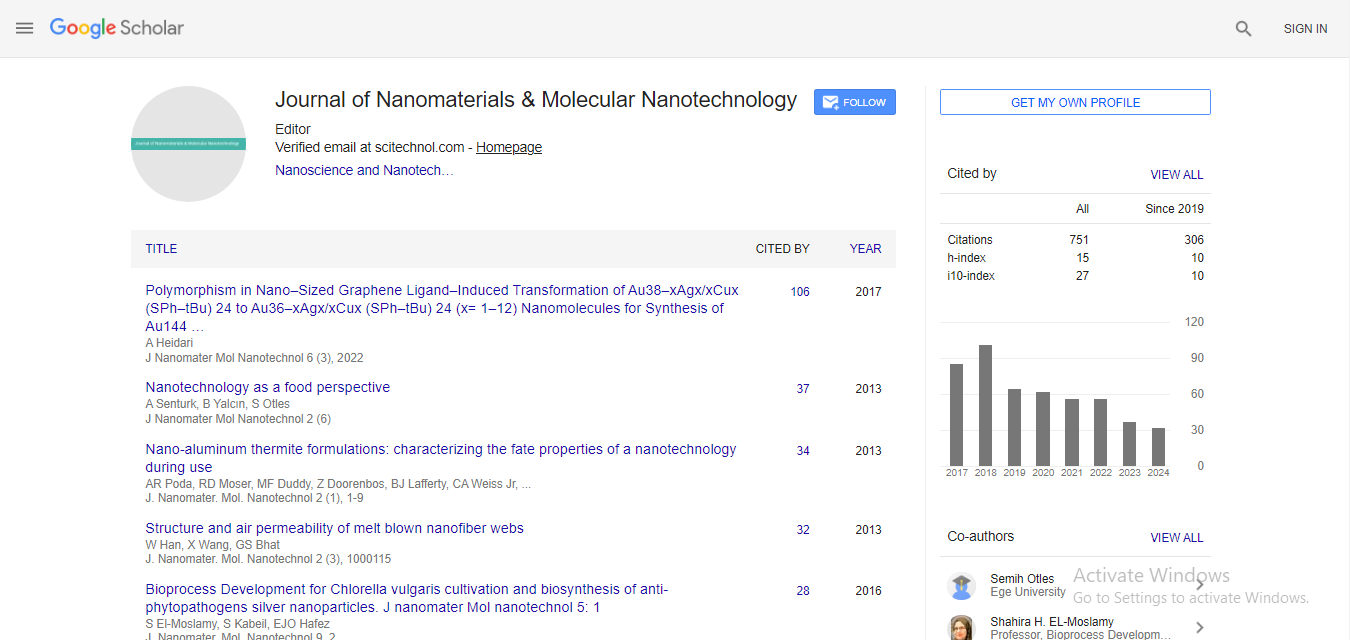Decorated, crumpled graphene oxide assemblies for advanced imaging applications
Rina Tannenbaum
Stony Brook University, USA
: J Nanomater Mol Nanotechnol
Abstract
Carbon nanomaterials (CNMs) are emerging as materials of interest in biomedical applications. In particular, the decoration and functionalization of such nano materials with a variety of nano particles may provide powerful signal enhancement in several tissue imaging techniques. Graphene oxide based CNMs (GO-CNMs) possess notable geometrical variants, such as flat sheets, tubes, scrolls and spheres and form stable and easily processable aqueous solutions. Furthermore, the presence of oxygen containing functional surface groups in GO-CNMs provide potential locations for attachment of drugs, disease targeting groups as well as decoration with metal nanoparticles, making them viable theranostics platforms. We synthesized mesoscale crumpled graphene oxide roses (GO roses) by using colloidal graphene oxide (GO) variants as precursors for a hybrid emulsification/rapid evaporation approach. This process produced rose like, spherical, reduced meso structures of colloidal graphene oxide with corrugated surfaces. This synthesis route provides control over particle size, morphology and chemical properties of the synthesized GO roses. We investigated the morphology and chemical structure of these produced GO roses was using electron microscopy (SEM, TEM and FIB-assisted SEM) and spectroscopy techniques (FTIR, Raman and XPS) at the CFN. We also studied the possible applications of these synthesized meso-structures as potential theranostics platforms for cancer remediation as MRI contrast, tissue delineation and drug delivery agents. Recent Publications 1. I T Kim, J Lee, M Shofner, K Jacob and R Tannenbaum (2012) Crystallization kinetics and anisotropic properties of polyethylene oxide/magnetic carbon nanotubes composite films. Polymer 53(12):2402-2411. 2. I T Kim, A Magasinski, G Yushin, K Jacob and R Tannenbaum (2013) Synthesis and electrochemical performance of reduced graphene oxide/maghemite composite as an anode material for lithium ion batteries. Carbon 52:56-64. 3. C G Carson, G Brunnello, S G Lee, S S Jang, R A Gerhardt and R Tannenbaum (2014) Structure solution from powder diffraction of copper 1,4-benzenedicarboxylate. European Journal of Inorganic Chemistry 12:2140–2145. 4. D Bhuiyan, M Yablonsky, J Middleton and R Tannenbaum (2015) The synthesis and characterization of nano-hydroxyapatite (nHAP)-g-poly (lactide-co-glycolide)-g-collagen polymer for tissue engineering scaffolds. Advanced Materials For Biological And Biomedical Applications 1569:27-32. 5. S Sharma, V H Pham, J A Boscoboinik, F Camino, J H Dickerson and R Tannenbaum (2018) Synthesis of meso scale, crumpled, reduced graphene oxide roses by water-in-oil emulsion approach. Materials Research Express 5(5):055601.
Biography
Rina Tannenbaum is a Professor in the Department of Materials Science and Chemical Engineering and a member of the Stony Brook Cancer Center at Stony Brook University in New York. To date she has published over 200 peer-reviewed articles, reviews and conference proceedings. She is the recipient of numerous awards such as the best paper award in the 1st International Conference on Applied Physics (2003), the Sigma Xi best thesis advisor award (2004), the MRS fall 2006 meeting outstanding paper award (2007) and the 1st prize in the SAIC best paper competition (2007 and 2010). She is a member of the advisory board of several professional journals and a member of several national and international professional societies. Her areas of interest are soft condensed matter and complex fluids, bio-based functional nanomaterials and bio-nanostructures tissue imaging and targeted drug delivery.
E-mail: irena.tannenbaum@stonybrook.edu
 Spanish
Spanish  Chinese
Chinese  Russian
Russian  German
German  French
French  Japanese
Japanese  Portuguese
Portuguese  Hindi
Hindi 



